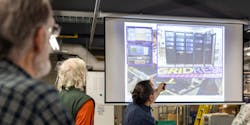St. Thomas University's Microgrid Research Center Gains $2M to Study AI-Power Management for EV Charging
Minnesota’s University of St. Thomas, already home to the campus Center for Microgrid Research, will partner with EV charging technology firm Bright.Green to build a new microgrid facility after receiving a $2 million investment to support next-gen distributed energy and artificial intelligence (AI)-ready research.
The Bright.Green investment will also help to establish Mahmoud Kabalan as Bright.Green Director for the University of St. Thomas Center for Microgrid Research. Kabalan, who heads the microgrid research work at the St. Paul campus, also is an advisory board member for the Microgrid Knowledge Conference happening April 15-17 in Dallas.
Bright.Green develops electric vehicle charging infrastructure monitoring, payment and compliance services. The funding and collaboration with St. Thomas will focus on designing a microgrid utilizing AI-driven power management, carbon-free energy and advanced grid technology to test EVs, electric buses and decentralized energy solutions.
“This facility will be among the most advanced in the world, developing groundbreaking solutions for grid modernization, energy security, and next-generation workforce training,” Kabalan said in a statement.
Work on the first $2 million microgrid at the University of St. Thomas started nearly a decade ago. The new partnership with Bright.Green gives the next microgrid project a new focus with cutting edge digitalization utilizing AI.
“At Bright.Green, we believe the future of energy lies in innovative, sustainable, and distributed power solutions,” said Jason Bright, principal investor and private equity founder. “This initiative is not just about research – it’s about creating real-world models for energy independence and security. We’re proud to support Dr. Kabalan and his team in developing next-generation grid technology and ensuring clean, efficient power is accessible to all.”
The St. Thomas Center for Microgrid Research was first established in 2014 when the School of Engineering was awarded a $1.5 million grant from utility Xcel Energy’s renewable development fund to build the microgrid research and test center.
The facility and school have provided education and research opportunities for students interested in developing microgrids.
In 2022, the research center received a $5.4 million grant from the Minnesota Renewable Development Account through the Minnesota Department of Commerce that helped expand the facility.
Learn more on the cutting edge of new microgrid development by attending the Microgrid Knowledge 2025 Conference at the Sheraton Dallas.
About the Author
Rod Walton, Microgrid Knowledge Managing Editor
Managing Editor
For Microgrid Knowledge editorial inquiries, please contact Managing Editor Rod Walton at [email protected].
I’ve spent the last 15 years covering the energy industry as a newspaper and trade journalist. I was an energy writer and business editor at the Tulsa World before moving to business-to-business media at PennWell Publishing, which later became Clarion Events, where I covered the electric power industry. I joined Endeavor Business Media in November 2021 to help launch EnergyTech, one of the company’s newest media brands. I joined Microgrid Knowledge in July 2023.
I earned my Bachelors degree in journalism from the University of Oklahoma. My career stops include the Moore American, Bartlesville Examiner-Enterprise, Wagoner Tribune and Tulsa World, all in Oklahoma . I have been married to Laura for the past 33-plus years and we have four children and one adorable granddaughter. We want the energy transition to make their lives better in the future.
Microgrid Knowledge and EnergyTech are focused on the mission critical and large-scale energy users and their sustainability and resiliency goals. These include the commercial and industrial sectors, as well as the military, universities, data centers and microgrids. The C&I sectors together account for close to 30 percent of greenhouse gas emissions in the U.S.
Many large-scale energy users such as Fortune 500 companies, and mission-critical users such as military bases, universities, healthcare facilities, public safety and data centers, shifting their energy priorities to reach net-zero carbon goals within the coming decades. These include plans for renewable energy power purchase agreements, but also on-site resiliency projects such as microgrids, combined heat and power, rooftop solar, energy storage, digitalization and building efficiency upgrades.

